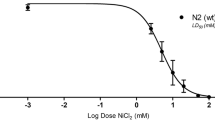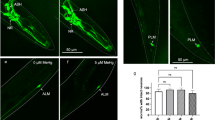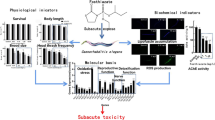Abstract
In the present study, we investigated the possibly neurotoxic effects of metal (Pb and Hg) exposure at different developmental stages on neuronal loss in the GABAergic nervous system and synaptic functions in the nematode Caenorhabditis elegans. Our data suggest that neuronal survival in GABAergic neurons and cholinergic transmission were relatively stable during development in nematodes. Moreover, neurodegeneration, as shown by the neuronal loss and dorsal/ventral cord gaps, was more severely induced by Pb and Hg exposure at the L1 through L3 larval stages than at the L4 larval and young-adult stages. Similarly, pre- and postsynaptic functions were more severely impaired by Pb and Hg exposure at the L1 through L3 larval stages than at the L4 larval and young-adult stages. Furthermore, both aldicarb and levamisole resistance were significantly correlated with neuronal loss, dorsal cord gap, and ventral cord gap in Pb- and Hg-exposed nematodes, suggesting that neuronal survival was noticeably correlated with synaptic function in metal-exposed nematodes during development. Therefore, younger (L1–L3) larvae show more sensitivity to neurotoxicity of neuronal survival and synaptic function than L4 larvae and young adult nematodes.




Similar content being viewed by others
References
Anderson GL, Boyd WA, Williams PL (2001) Assessment of sublethal endpoints for toxicity testing with the nematode Caenorhabditis elegans. Environ Toxicol Chem 20:833–838. doi:10.1897/1551-5028(2001)020<0833:AOSEFT>2.0.CO;2
Anderson GL, Cole RD, Williams PL (2004) Assessing behavioral toxicity with Caenorhabditis elegans. Environ Toxicol Chem 23:1235–1240. doi:10.1897/03-264
Bamber BA, Beg AA, Twyman RE, Jorgensen EM (1999) The Caenorhabditis elegans unc-49 locus encodes multiple subunits of a heteromultimeric GABA receptor. J Neurosci 19:5348–5359
Brenner S (1974) The genetics of Caenorhabditis elegans. Genetics 77:71–94
Cao XJ, Huang SH, Wang M, Chen JT, Ruan DY (2008) S-Adenosyl-1-methionine improves impaired hippocampal long-term potentiation and water maze performance induced by developmental lead exposure in rats. Eur J Pharmacol 595:30–34. doi:10.1016/j.ejphar.2008.07.061
Chu KW, Chow KL (2002) Synergistic toxicity of multiple heavy metals is revealed by a biological assay using a nematode and its transgenic derivative. Aquat Toxicol 61:53–64. doi:10.1016/S0166-445X(02)00017-6
Cole RD, Anderson GL, Williams PL (2004) The nematode Caenorhabditis elegans as a model of organophosphate-induced mammalian neurotoxicity. Toxicol Appl Pharmacol 194:248–256. doi:10.1016/j.taap.2003.09.013
Cooper GP, Manalis RS (1984) Interactions of lead and cadmium on acetylcholine release at the frog neuromuscular junction. Toxicol Appl Pharmacol 74:411–416. doi:10.1016/0041-008X(84)90294-1
Dhawan R, Dusenbery DB, Williams PL (2000) A comparison of metal-induced lethality and behavioral responses in the nematode Caenorhabditis elegans. Environ Toxicol Chem 19:3061–3067. doi:10.1897/1551-5028(2000)019<3061:ACOMIL>2.0.CO;2
Donkin S, Williams PL (1995) Influence of developmental stage, salts and food presence on various end points using Caenorhabditis elegans for aquatic toxicity testing. Environ Toxicol Chem 14:2139–2147. doi:10.1897/1552-8618(1995)14[2139:IODSSA]2.0.CO;2
Du M, Wang D-Y (2008) The neurotoxic effects of heavy metal exposure on GABAergic system in nematode Caenorhabditis elegans. Environ Toxicol Pharmacol. doi:10.1016/j.etap.2008.11.011
Gao Y, Yan C, Tian Y, Wang Y, Xie H, Zhou X, Yu X, Yu X, Tong S, Zhou Q, Shen X (2007) Prenatal exposure to mercury and neurobehavioral development of neonates in Zhoushan City, China. Environ Res 105:390–399. doi:10.1016/j.envres.2007.05.015
Gilbert ME, Kelly ME, Samsam TF, Goodman JH (2005) Chronic developmental lead exposure reduces neurogenesis in adult rat hippocampus but does not impair spatial learning. Toxicol Sci 86:365–374. doi:10.1093/toxsci/kfi156
Gill KD, Gupta V, Sandhir R (2003) Ca2+/calmodulin-mediated neurotransmitter release and neurobehavioral deficits following lead exposure. Cell Biochem Funct 21:345–353. doi:10.1002/cbf.1030
Graves AL, Boyd WA, Williams PL (2005) Using transgenic Caenorhabditis elegans in soil toxicity testing. Arch Environ Contam Toxicol 48:490–494. doi:10.1007/s00244-004-0031-2
Hu Y-O, Wang Y, Ye B-P, Wang D-Y (2008) Phenotypic and behavioral defects induced by iron exposure can be transferred to progeny in Caenorhabditis elegans. Biomed Environ Sci 21:467–473. doi:10.1016/S0895-3988(09)60004-0
Jones D, Candido EPM (1999) Feeding is inhibited by sublethal concentrations of toxicants and by heat stress in the nematode Caenorhabditis elegans: relationship to the cellular stress response. J Exp Zool 284:147–157. doi:10.1002/(SICI)1097-010X(19990701)284:2<147::AID-JEZ4>3.0.CO;2-Z
Juárez BI, Martínez ML, Dufour L, García E, Jiménez-Capdeville ME (2002) Methylmercury increases glutamate extracellular levels in frontal cortex of awake rats. Neurotoxicol Teratol 24:767–771. doi:10.1016/S0892-0362(02)00270-2
Kraemer BC, Zhang B, Leverenz JB, Thomas JH, Trojanowski JQ, Schellenberg GD (2003) Neurodegeneration and defective neurotransmission in a Caenorhabditis elegans model of taupathy. Proc Natl Acad Sci USA 100:9980–9985. doi:10.1073/pnas.1533448100
Landrigan PJ, Sonawane B, Butler RN, Trasande L, Callan R, Droller D (2005) Early environmental origans of neurodegerative disease in later life. Environ Health Perspect 113:1230–1233
Leong CC, Syed NI, Lorscheider FL (2001) Retrograde degeneration of neurite membrane structural integrity of nerve growth cones following in vitro exposure to mercury. Neuroreport 12:733–737. doi:10.1097/00001756-200103260-00024
Leung MCK, Williams PL, Benedetto A, Au C, Helmcke KJ, Aschner M, Meyer JN (2008) Caenorhabditis elegans: an emerging model in biomedical and environmental toxicology. Toxicol Sci 106:5–28. doi:10.1093/toxsci/kfn121
McIntire SL, Jorgensen E, Kaplan J, Horvitz HR (1993) The GABAergic nervous system of Caenorhabditis elegans. Nature 364:337–341. doi:10.1038/364337a0
Monnet-Tschudi F, Zurich MG, Boschat C, Corbaz A, Honegger P (2006) Involvement of environmental mercury and lead in the etiology of neurodegenerative diseases. Rev Environ Health 21:105–117
Morley EJ, Hirsch HV, Hollocher K, Lnenicka GA (2003) Effects of chronic lead exposure on the neuromuscular junction in Drosophila larvae. Neurotoxicology 24:35–41. doi:10.1016/S0161-813X(02)00095-5
Mutwakil MHAZ, Reader JP, Holdich DM, Smithurst PR, Candido EPM, Jones D, Stringham EG, de Pomerai DI (1997) Use of stress-inducible transgenic nematodes as biomarkers of heavy metal pollution in water samples from an English river system. Arch Environ Contam Toxicol 32:146–153. doi:10.1007/s002449900167
Onishchenko N, Tamm C, Vahter M, Hökfelt T, Johnson JA, Johnson DA, Ceccatelli S (2007) Developmental exposure to methylmercury alters learning and induces depression-like behavior in male mice. Toxicol Sci 97:428–437. doi:10.1093/toxsci/kfl199
Rajini PS, Melstrom P, Williams PL (2008) A comparative study on the relationship between various toxicological endpoints in Caenorhabditis elegans exposed to organophosphorus insecticides. J Toxicol Environ Health A 71:1043–1050. doi:10.1080/15287390801989002
Riddle DL, Blumenthal T, Meyer BJ, Priess JR (1997) C. ELEGANS II. Cold Spring Harbor Laboratory Press, Plainview
Roos PM, Vesterberg O, Nordberg M (2006) Metals in motor neuron diseases. Exp Biol Med 231:1481–1487
Stewart WF, Schwartz BS, Davatzikos C, Shen D, Liu D, Wu X, Todd AC, Shi W, Bassett S, Youssem D (2006) Past adult lead exposure is linked to neurodegeneration measured by brain MRI. Neurology 66:1476–1484. doi:10.1212/01.wnl.0000216138.69777.15
Sui L, Ruan DY (2000) Impairment of the Ca2+-permeable AMPA/kainate receptors by lead exposure in organotypic rat hippocampal slice cultures. Pharmacol Toxicol 87:204–210. doi:10.1034/j.1600-0773.2000.d01-75.x
Sun L, Zhao ZY, Hu J, Zhou XL (2005) Potential association of lead exposure during early development of mice with alteration of hippocampus nitric oxide levels and learning memory. Biomed Environ Sci 18:375–378
Suszkiw J, Toth G, Murawsky M, Cooper GP (1984) Effects of Pb2+ and Cd2+ on acetylcholine release and Ca2+ movements in synaptosomes and subcellular fractions from rat brain and Torpedo electric organ. Brain Res 323:31–46. doi:10.1016/0006-8993(84)90262-2
Takaoka S, Kawakami Y, Fujino T, Oh-ishi F, Motokura F, Kumagai Y, Miyaoka T (2008) Somatosensory disturbance by methylmercury exposure. Environ Res 107:6–19. doi:10.1016/j.envres.2007.05.012
Verina T, Rohde CA, Guilarte TR (2007) Environmental lead exposure during early life alters granule cell neurogenesis and morphology in the hippocampus of young adult rats. Neuroscience 145:1037–1047. doi:10.1016/j.neuroscience.2006.12.040
Wang D-Y, Yang P (2007) The multi-biological defects caused by lead exposure exhibit transferable properties from exposed parents to their progeny in Caenorhabditis elegans. J Environ Sci 19:1367–1372. doi:10.1016/S1001-0742(07)60223-X
Wang D-Y, Xing X-J (2008) Assessment of locomotion behavioral defects induced by acute toxicity from heavy metal exposure in nematode Caenorhabditis elegans. J Environ Sci 20:1132–1137. doi:10.1016/S1001-0742(08)62160-9
Wang D-Y, Shen L-L, Wang Y (2007a) The phenotypic and behavioral defects can be transferred from zinc exposed nematodes to their progeny. Environ Toxicol Pharmacol 24:223–230. doi:10.1016/j.etap.2007.05.009
Wang L, Luo L, Luo YY, Gu Y, Ruan DY (2007b) Effects of Pb2+ on muscarinic modulation of glutamatergic synaptic transmission in rat hippocampal CA1 area. Neutotoxicology 28:499–507. doi:10.1016/j.neuro.2006.11.003
Wang Y, Xie W, Wang D-Y (2007c) Transferable properties of multi-biological toxicity caused by cobalt exposure in Caenorhabditis elegans. Environ Toxicol Chem 26:2405–2412. doi:10.1897/06-646R1.1
White JG, Southgate E, Thomson JN, Brenner S (1986) The structure of the nervous system of the nematode Caenorhabditis elegans. Philos Trans R Soc Lond B Biol Sci 314:1–340. doi:10.1098/rstb.1986.0056
Williams PL, Dusenbery DB (1990) A promising indicator of neurobehavioral toxicity using the nematode Caenorhabditis elegans and computer tracking. Toxicol Ind Health 6:425–440
Winder C, Garten LL, Lewis PD (1983) The morphological effects of lead on the developing central nervous system. Neuropathol Appl Neurobiol 9:87–108. doi:10.1111/j.1365-2990.1983.tb00328.x
Ye H-Y, Ye B-P, Wang D-Y (2008a) Evaluation of the long-term memory for the thermosensation regulation by NCS-1 in Caenorhabditis elegans. Neurosci Bull 24:1–6. doi:10.1007/s12264-008-0920-x
Ye H-Y, Ye B-P, Wang D-Y (2008b) Trace administration of vitamin E can retrieve and prevent UV-irradiation- and metal exposure-induced memory deficits in nematode Caenorhabditis elegans. Neurobiol Learn Mem 90:10–18. doi:10.1016/j.nlm.2007.12.001
Acknowledgments
Strains used in this study were provided by the Caenorhabdits Genetics Center (funded by the NIH National Center for Research Resources, USA). This work was supported by grants from the National Natural Science Foundation of China (Nos. 30771113 and 30870810) and the Program for New Century Excellent Talents in University.
Author information
Authors and Affiliations
Corresponding author
Rights and permissions
About this article
Cite this article
Xing, XJ., Rui, Q., Du, M. et al. Exposure to Lead and Mercury in Young Larvae Induces More Severe Deficits in Neuronal Survival and Synaptic Function than in Adult Nematodes. Arch Environ Contam Toxicol 56, 732–741 (2009). https://doi.org/10.1007/s00244-009-9307-x
Received:
Accepted:
Published:
Issue Date:
DOI: https://doi.org/10.1007/s00244-009-9307-x




